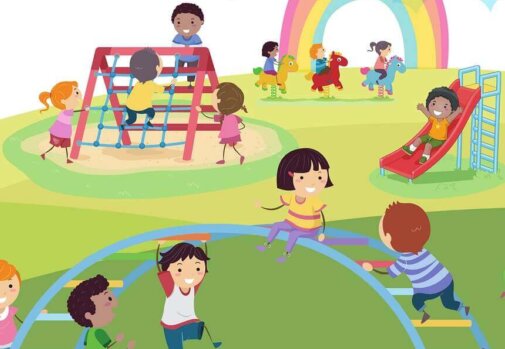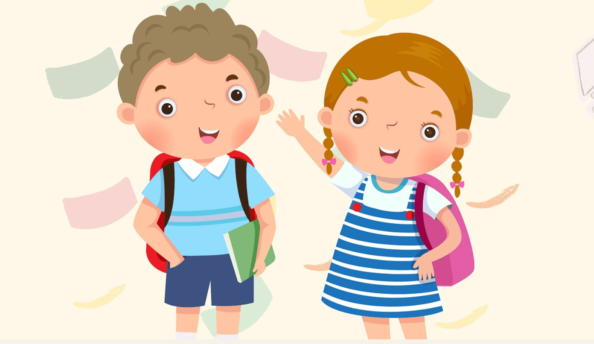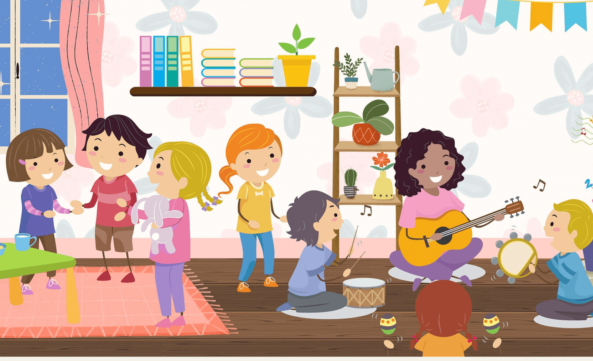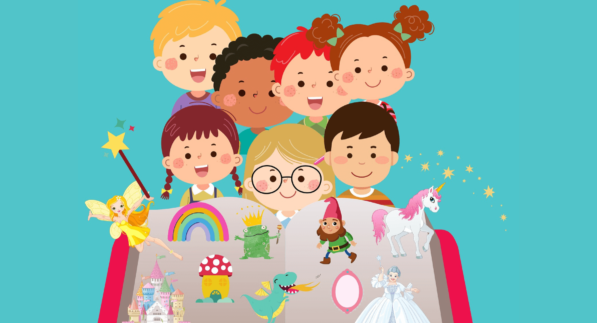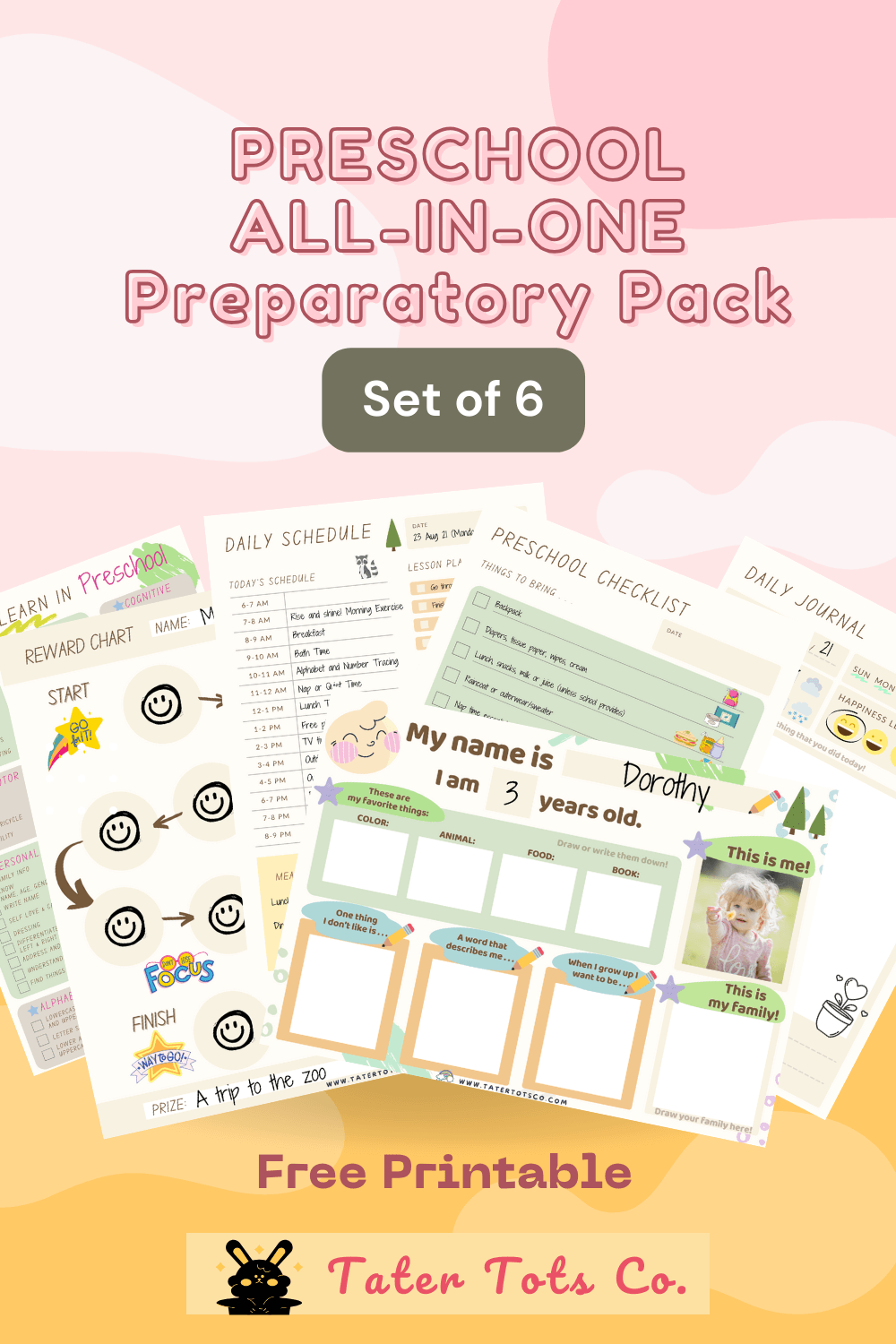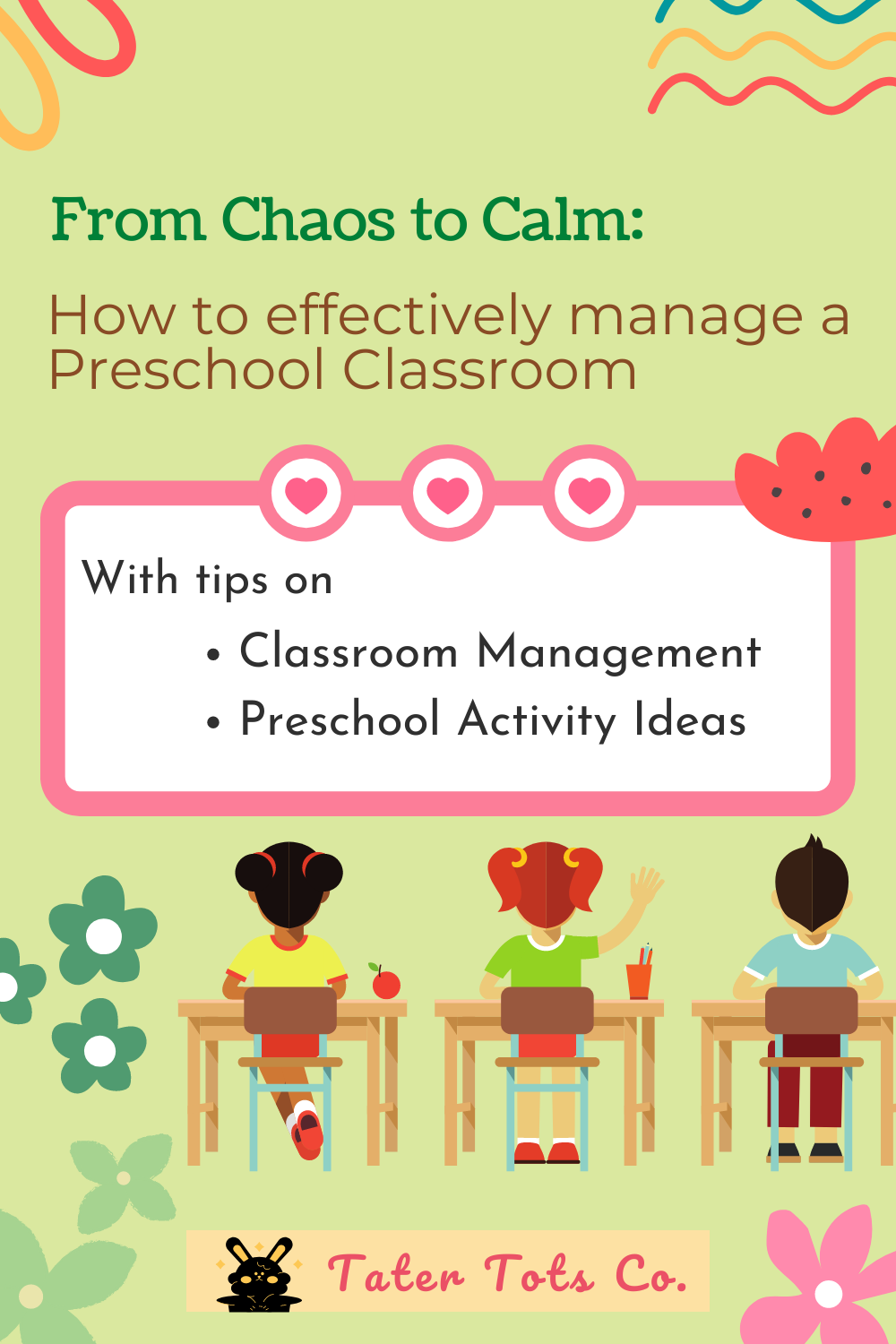
From Chaos to Calm: How to effectively manage a Preschool Classroom
Introduction
Preschool teachers play a crucial role in shaping young minds and preparing them for their educational journey. However, managing a room full of lively and curious preschoolers can be a daunting task.
Keeping children engaged, focused, and on-task can be a challenge, but with the right classroom management techniques, it can be done. Effective classroom management is essential to create a safe and conducive learning environment for young children.
In this article, we will provide you with some effective tips and strategies that will help you transform your chaotic preschool classroom into a calm and organized learning space. From creating a daily routine and establishing clear rules and expectations to using positive reinforcement and building relationships with your students, read on to discover how you can improve your classroom management skills and create a positive learning experience for your preschoolers.
Related Article: Why Do We Need Classroom and Homeschool Rules? Get A Free Classroom Rules Template To Implement Them Now!
The Importance of Classroom Management in Preschool
Classroom management plays a pivotal role in creating a positive and conducive learning environment for preschoolers. As any experienced preschool teacher knows, the early years of a child’s education are crucial for their overall development and growth. Effective classroom management techniques not only foster a sense of structure and order but also promote a sense of security, engagement, and active participation among young learners.
Preschool classrooms are often filled with an abundance of energy, curiosity, and the occasional chaos. It is within this dynamic environment that teachers must establish clear expectations, routines, and boundaries to ensure smooth daily operations. By implementing effective classroom management strategies, preschool teachers can create an atmosphere that fosters learning, nurtures social-emotional development, and maximizes the potential of each child.
A well-managed classroom provides preschoolers with a sense of stability and predictability. When students understand what is expected of them and feel safe in their learning environment, they are more likely to actively engage in activities, follow instructions, and develop positive relationships with their peers. Moreover, effective classroom management empowers teachers to focus on delivering quality instruction, as they spend less time addressing behavior issues and more time supporting individual student needs.
We will delve into various practical and proven strategies that preschool teachers can employ to transform their classrooms from chaotic to calm. From establishing consistent routines and implementing positive behavior reinforcement techniques to creating engaging learning centers and fostering a sense of community, we will explore a range of approaches that can help teachers effectively manage their classrooms and lay the foundation for a successful preschool experience.
Remember, the journey from chaos to calm is not an overnight process but rather a continuous effort that requires patience, consistency, and a deep understanding of early childhood development. By prioritizing classroom management, preschool teachers can create an environment where young learners thrive, grow, and develop a lifelong love for learning.
So, let’s dive in and uncover the valuable tools and strategies that will empower you to create a harmonious and enriching preschool classroom.
Set Clear Expectations and Rules
Setting clear expectations and rules is a fundamental aspect of effective classroom management for preschool teachers. Young children thrive in structured environments where they understand the boundaries and know what is expected of them. By establishing clear expectations and rules, teachers create a sense of predictability and security, which promotes a calm and focused learning atmosphere.
To begin, it is crucial to communicate the expectations and rules to the preschoolers in a clear and age-appropriate manner. Use simple language and visual aids such as posters or charts to reinforce the guidelines. Make sure the rules are easy to understand and remember, using concise phrases like “listen when others are talking,” “keep hands and feet to yourself,” or “use kind words.”
Consistency is key when enforcing these expectations and rules. Preschoolers need regular reminders and reinforcement to internalize the guidelines. Be consistent in your approach and follow through with consequences when rules are not followed. However, it is equally important to provide positive reinforcement and praise when children adhere to the expectations. This encourages them to make positive choices and reinforces the desired behavior.
Creating a supportive and inclusive classroom environment is also essential when setting expectations and rules. Involve the preschoolers in the process by discussing why certain rules are in place and how they contribute to a harmonious learning environment. Encourage open communication and problem-solving, allowing children to express their thoughts and concerns. This fosters a sense of ownership and responsibility among the preschoolers, promoting their engagement in maintaining the established rules.
It is beneficial to regularly review and revisit the expectations and rules throughout the school year. As preschoolers grow and develop, their understanding and behavior evolve as well. Take the time to discuss the rules periodically, reinforcing their importance and addressing any emerging challenges or questions.
By setting clear expectations and rules in the preschool classroom, teachers provide a framework for positive behavior and create an environment where children can thrive. This foundation of structure and consistency sets the stage for effective classroom management, transforming chaos into calmness and facilitating a supportive and productive learning experience for all.
Establish Routines and Procedures
Establishing routines and procedures is a crucial aspect of effective classroom management for preschool teachers. Young children thrive in environments that provide structure and predictability, as it helps them feel secure and understand what is expected of them. By establishing clear routines and procedures, teachers can create a calm and organized learning environment that fosters positive behavior and maximizes instructional time.
One way to establish routines is by creating a daily schedule that outlines the activities and transitions throughout the day. This schedule should be displayed in a visible place in the classroom, such as a whiteboard or bulletin board so that children can refer to it and anticipate what comes next. Consistency is key when it comes to routines, so it is important to adhere to the schedule as much as possible.
In addition to a daily schedule, teachers should establish procedures for various classroom activities and transitions. For example, there should be a procedure for entering and leaving the classroom, lining up, using the restroom, and cleaning up after activities. These procedures can be taught and practiced with the children until they become second nature.
When introducing routines and procedures, it is important to explain them clearly and model the expected behavior for the children. Use simple and age-appropriate language to ensure understanding. Visual aids, such as pictures or charts, can also be helpful in reinforcing routines and procedures.
Repetition is key when it comes to establishing routines and procedures. Consistently reinforce the expectations and remind children of the procedures throughout the day. Praise and acknowledge positive behavior when children follow the routines and procedures correctly. Consistency, praise, and reinforcement will help children internalize the expectations and make them a natural part of their daily routine.
By establishing routines and procedures, preschool teachers can create a structured and predictable environment that promotes positive behavior and enhances the learning experience for young children. It sets the foundation for a calm and organized classroom, allowing both teachers and students to focus on the joy of learning and growth.
Use Positive Reinforcement and Rewards
Positive reinforcement and rewards are powerful tools for maintaining a calm and structured classroom environment. Preschoolers thrive on praise and recognition, so utilizing positive reinforcement techniques can greatly enhance their behavior and motivation to participate in classroom activities.
One effective strategy is to implement a reward system. This can be as simple as a sticker chart or a more elaborate system with tokens or points that can be exchanged for small prizes or privileges. The key is to clearly define the desired behaviors and set achievable goals for the children.
When a child exhibits positive behavior, such as sharing, listening attentively, or completing tasks, acknowledge and praise their efforts immediately. Use specific and descriptive language to highlight what they did well, reinforcing their understanding of the behavior you want to encourage.
Offering small rewards, such as a special privilege or a small treat, can further motivate preschoolers to engage in positive behaviors. However, it’s important to emphasize intrinsic rewards, such as the feeling of accomplishment or pride, alongside extrinsic rewards. This helps children develop an understanding of the inherent value of positive behavior and encourages them to internalize good habits.
It’s crucial to be consistent with reinforcement and rewards to create a predictable and fair environment. Establish clear guidelines for earning rewards and ensure that all children have equal opportunities to participate. This fosters a sense of equity and encourages healthy competition and cooperation among the students.
Remember, while positive reinforcement and rewards are effective tools, it’s equally important to avoid excessive or inappropriate use. Over-reliance on rewards can diminish intrinsic motivation and may lead to dependency on external reinforcement. Therefore, it’s essential to strike a balance and use positive reinforcement as part of a comprehensive classroom management approach that also includes clear rules, routines, and effective communication with students and their families.
Create a Positive and Nurturing Environment
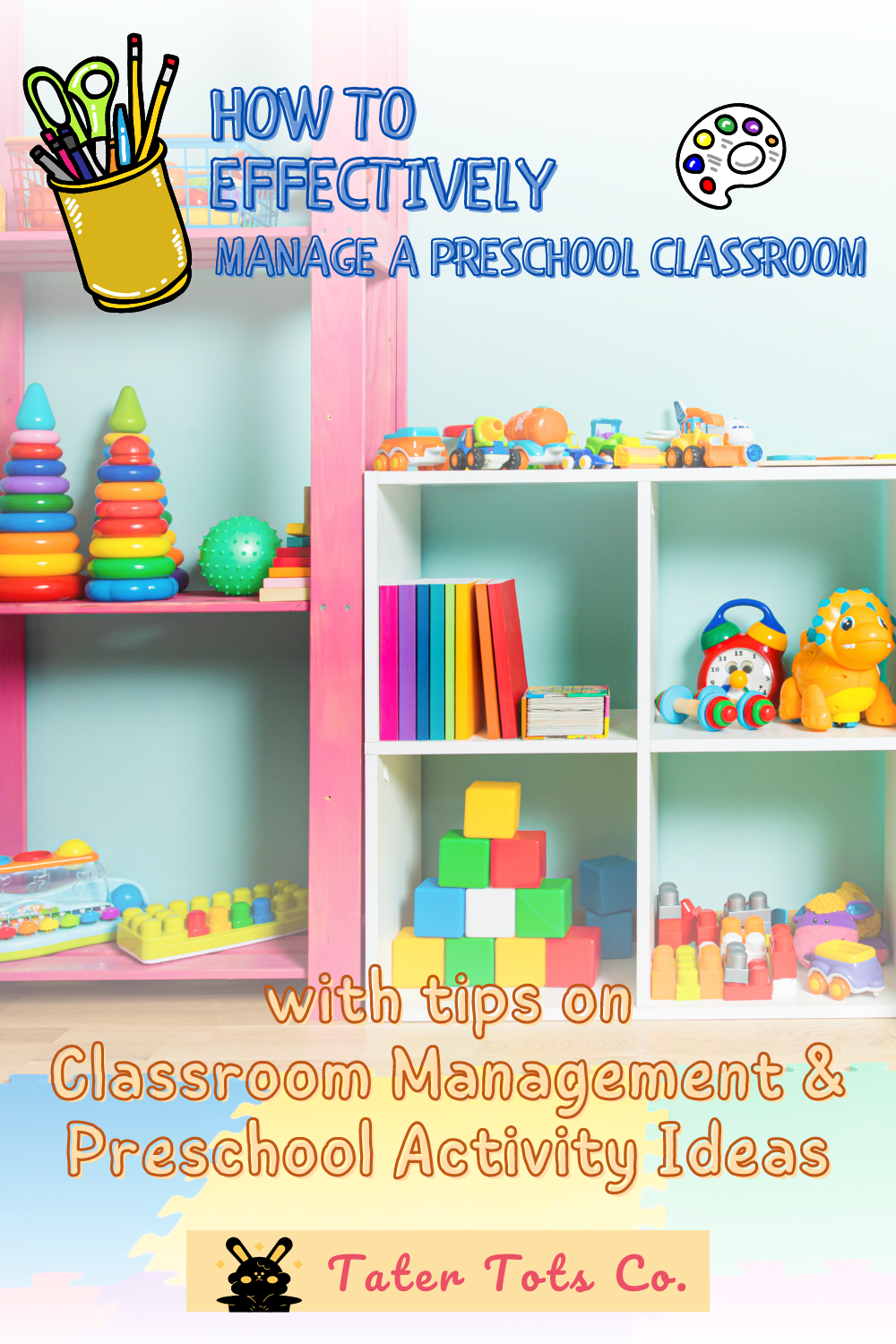
Creating a positive and nurturing environment is essential for effective classroom management in a preschool setting. As a preschool teacher, it is crucial to establish an atmosphere where children feel safe, supported, and motivated to learn.
One way to achieve this is by setting clear expectations and rules from the beginning. This can include rules about sharing, taking turns, using kind words, and respecting personal space. Display these rules in a visual and age-appropriate manner, such as through colorful posters or charts, so that children can easily understand and remember them.
In addition to rules, it is important to create a welcoming and engaging physical space. Arrange the classroom in a way that promotes exploration, creativity, and collaboration. Use bright colors, educational posters, and interactive learning centers to stimulate children’s curiosity and interest. Arrange furniture and materials in an organized and accessible manner to encourage independent learning and minimize distractions.
Building strong relationships with your students is another crucial aspect of creating a positive environment. Take the time to get to know each child individually, their interests, strengths, and challenges. Show genuine care and interest in their thoughts and feelings. By fostering a sense of belonging and connection, children will feel comfortable expressing themselves and seeking support when needed.
Promote positive behavior by acknowledging and reinforcing good actions. Praise and reward children when they demonstrate kindness, cooperation, or effort in their learning. Use verbal affirmations, stickers, or small incentives to motivate and encourage positive behaviors. By focusing on positive reinforcement rather than solely on discipline, you create an environment where children feel valued and motivated to make good choices.
Finally, create a calm and soothing atmosphere by incorporating relaxation techniques and mindfulness activities into the daily routine. Teach children simple breathing exercises, yoga poses, or guided imagery to help them relax, focus, and manage their emotions. By providing opportunities for quiet reflection and self-regulation, children learn valuable skills to cope with stress or frustration.
Creating a positive and nurturing environment in your preschool classroom sets the foundation for successful classroom management. By establishing clear expectations, providing engaging learning spaces, building strong relationships, fostering positive behavior, and incorporating relaxation techniques, you can transform chaos into calm and create a classroom where children thrive and love to learn.
Emotional Regulation posters
Help your students manage their emotions with these emotional regulation posters. Suitable for young kids to elementary students, these posters are perfect for display in a calm-down corner or classroom wall. Teach your students the skills they need to regulate their emotions and feel more in control.
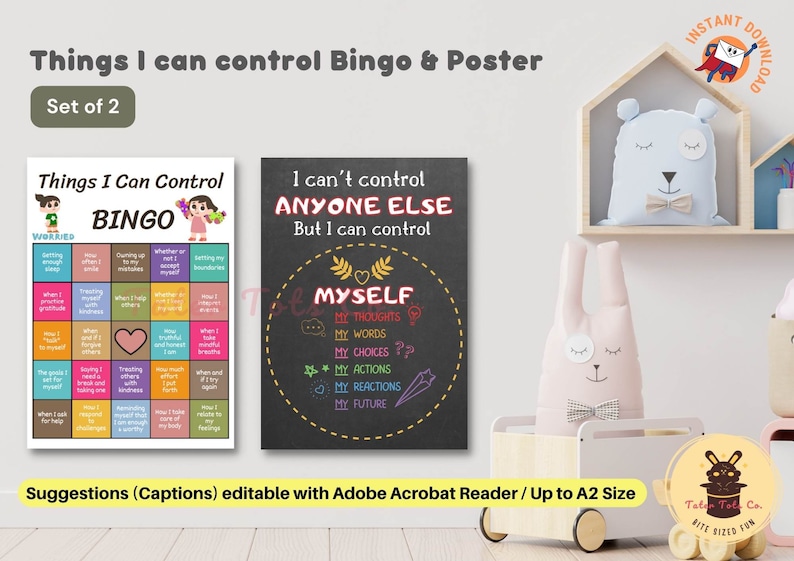
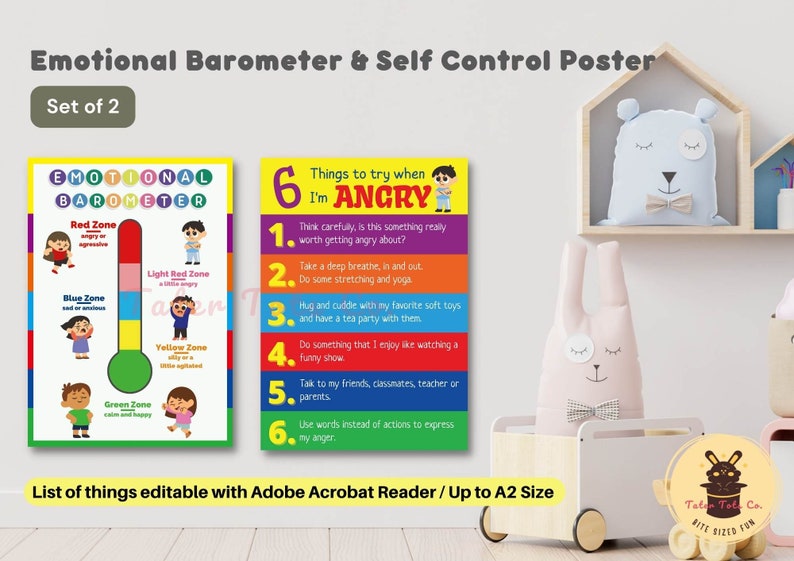
Have a good lesson plan
Set aside time to plan lessons. As young kids like to stray and have short focus levels, it’s important to plan transition activities.
These can be simple songs or short activities that keep children focused and less distracted between activities.
Make it a point to get to know each student and foster connections with them one on one. This will help children to focus better on their activities when you have their attention.
Incorporate Engaging and Interactive Activities
Incorporating engaging and interactive activities is a key component of effective classroom management for preschool teachers. Young children thrive in an environment that stimulates their curiosity and actively involves them in the learning process. By incorporating engaging activities, you can create a dynamic and interactive classroom that keeps children focused and excited about their education.
One way to incorporate engaging activities is through hands-on learning experiences. This can include interactive games, sensory activities, and experiments that allow children to explore and discover new concepts. For example, you might set up a science station where children can observe and interact with different materials, or create a dramatic play area where they can role-play and engage in imaginative play.
Another effective strategy is to incorporate movement and physical activity into the daily routine. Preschoolers have an abundance of energy, and providing opportunities for them to move and be active can help them stay engaged and focused. This can be as simple as incorporating movement breaks throughout the day, such as dancing or stretching exercises, or incorporating gross motor activities like obstacle courses or outdoor play.
Technology can also be a valuable tool for engaging preschoolers in the learning process. There are numerous educational apps and interactive resources available that can enhance their learning experience. Incorporating technology in a thoughtful and purposeful way can provide children with new and exciting ways to explore and learn.
In summary, incorporating engaging and interactive activities is crucial for effective classroom management in a preschool setting. By providing hands-on experiences, incorporating movement and physical activity, and utilizing technology, you can create a dynamic and stimulating learning environment that keeps children actively engaged and excited about their education.
Get to know them
Get to know their interests while keeping them meaningfully engaged and creating opportunities for them to showcase responsibility and leadership.
By getting to know them, you will be able to cater to different needs. Through observing them you can better develop strategies to maximize their learning potential.
Foster a Strong Relationship with Parents and Caregivers
Fostering a strong relationship with parents and caregivers is a crucial aspect of effective classroom management for preschool teachers. When parents and caregivers feel valued and involved in their child’s education, it creates a positive and supportive environment for both the child and the teacher.
One way to establish this relationship is through open and regular communication. Keeping parents informed about their child’s progress, activities, and any concerns or achievements can help build trust and keep them engaged in their child’s learning journey. Utilize various communication channels such as emails, newsletters, or even a dedicated classroom website to share updates and important information.
In addition to regular communication, it is essential to schedule parent-teacher conferences or meetings to discuss the child’s development, strengths, and areas for improvement. These meetings provide an opportunity to address any concerns, answer questions, and work collaboratively to support the child’s educational and social-emotional growth.
Inviting parents and caregivers to participate in classroom activities or special events can also contribute to a strong relationship. Organize family engagement activities such as parent volunteering days, family reading nights, or celebrations where parents can actively participate and interact with their child in the classroom setting. This involvement helps parents feel connected to their child’s educational experience and builds a sense of community among the students and families.
Furthermore, actively seeking input and feedback from parents and caregivers regarding their child’s needs, interests, and learning styles can be invaluable. This information can assist teachers in tailoring their lesson plans and activities to meet the individual needs of each child, fostering a more inclusive and personalized learning environment.
By fostering a strong relationship with parents and caregivers, preschool teachers can create a collaborative partnership that supports the child’s overall development. This partnership ultimately leads to a more harmonious classroom environment, where teachers and families work together to ensure the child’s success and create a calm and nurturing space for learning.
Enforcing Classroom Rules
Utilize Visual Aids and Visual Schedules
Visual aids and visual schedules are powerful tools that can greatly enhance classroom management in a preschool setting. Young children are visual learners, and having visual cues and reminders can help them understand and follow classroom routines and expectations more effectively.
One way to utilize visual aids is by creating a visual schedule for the day. This can be a simple chart or display that outlines the different activities and transitions throughout the day. By having a visual representation of what comes next, children can anticipate and prepare for the upcoming change, reducing anxiety and confusion. It also helps them develop a sense of structure and routine, which is essential for a well-managed classroom.
Visual aids can also be used to communicate expectations and rules. For example, you can create visual reminders for important classroom rules such as “raising hands when speaking” or “taking turns.” These visuals can be displayed in relevant areas of the classroom as a constant reminder for the children.
Additionally, using visual cues, such as pictures or symbols, can help children understand and remember instructions more easily. Incorporating visual aids into classroom management strategies not only benefits the children but also provides a helpful tool for the teacher. It allows for clear and consistent communication, especially for children who may have difficulty understanding verbal instructions alone. It also saves time and reduces frustration by providing a visual reference for children to refer back to when they need reminders or guidance.
When using visual aids and schedules, it’s important to keep them visually appealing and engaging for the children. Use bright colors, clear images, and age-appropriate visuals that capture their attention and make the information easily understandable. Regularly update the visuals as needed to reflect any changes in the routine or classroom expectations.
By incorporating visual aids and schedules into your classroom management approach, you create a more structured and organized learning environment for your preschoolers. It promotes independence, reduces behavioral issues, and ultimately contributes to a more calm and focused classroom atmosphere.
Examples of Classroom Rules
These are some examples of customized classroom rules for preschool and various occasions. Designed to help young students understand and follow the expectations of the classroom and get used to daily school routines, these customized rules provide clear guidance for your preschoolers.
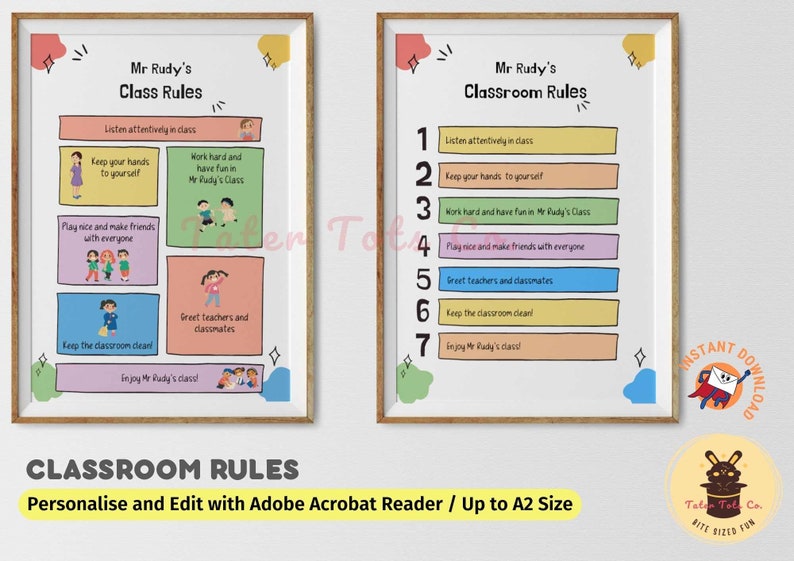

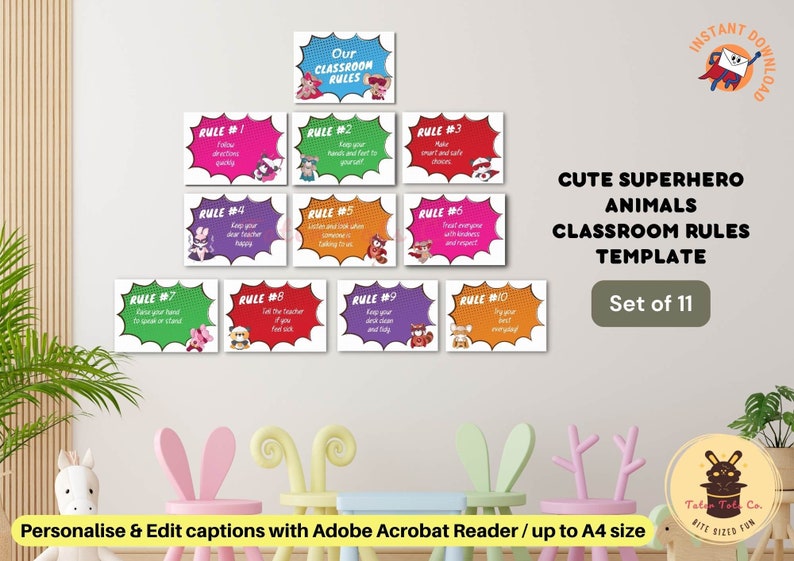
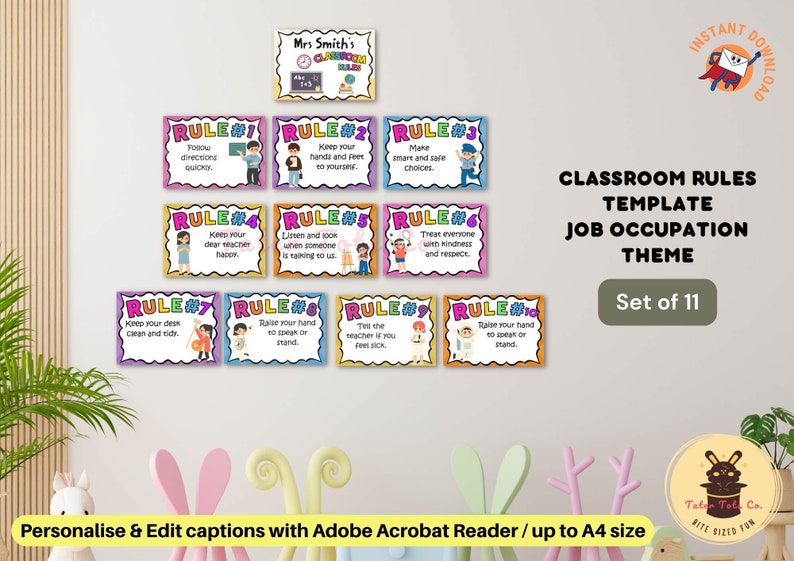
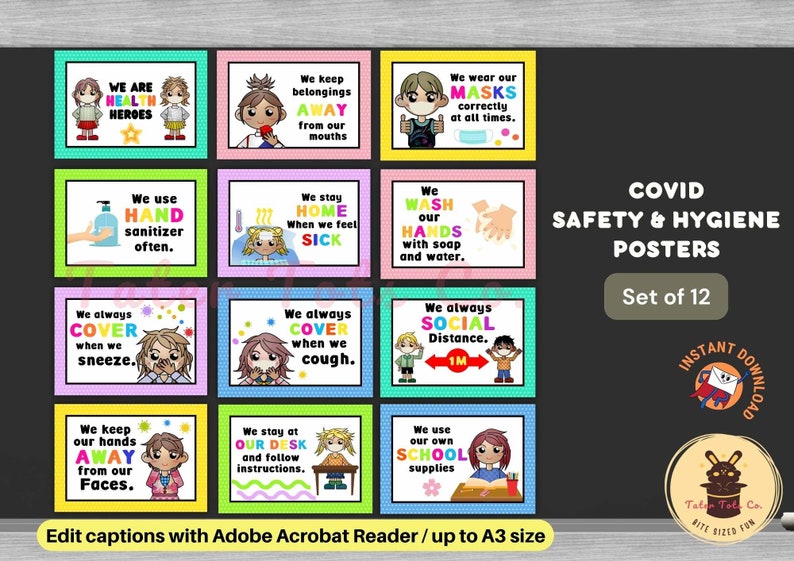
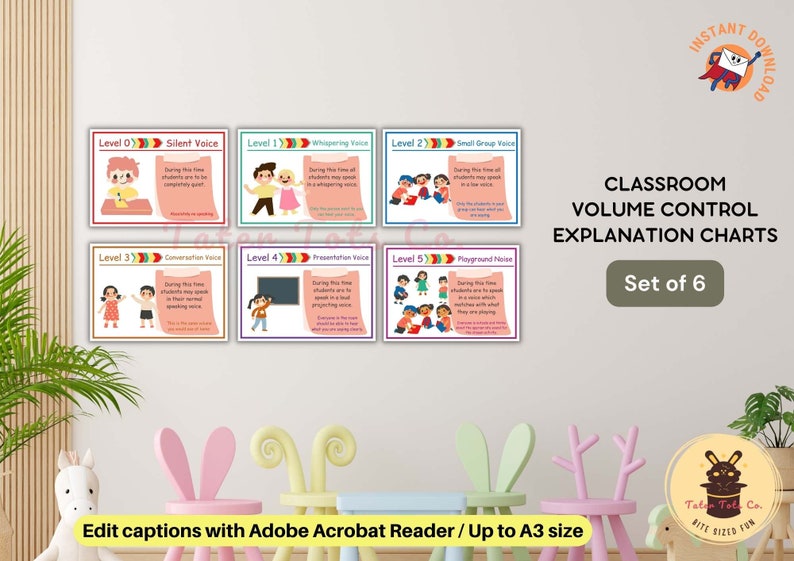
Create Sections for different types of play
To make play more interactive and engaging, segregate the classroom into different corners using Preschool Section Signs.
For example, there could be a reading corner, a calm down corner, a corner for puzzles and games, music, science, math, and dramatic play.
It gives the classroom a very organized and inclusive feel while making children feel welcome every day. It also allows children to follow their interests and explore what they like.
Preschool Section Signs
Organize your preschool classroom with these section signs. Designed to segregate the classroom into different play areas, these signs help young kids understand the functions of an activity or room.
You can ensure that your students know how to behave in each area with engaging visuals. Create a structured and engaging learning environment for your preschoolers.
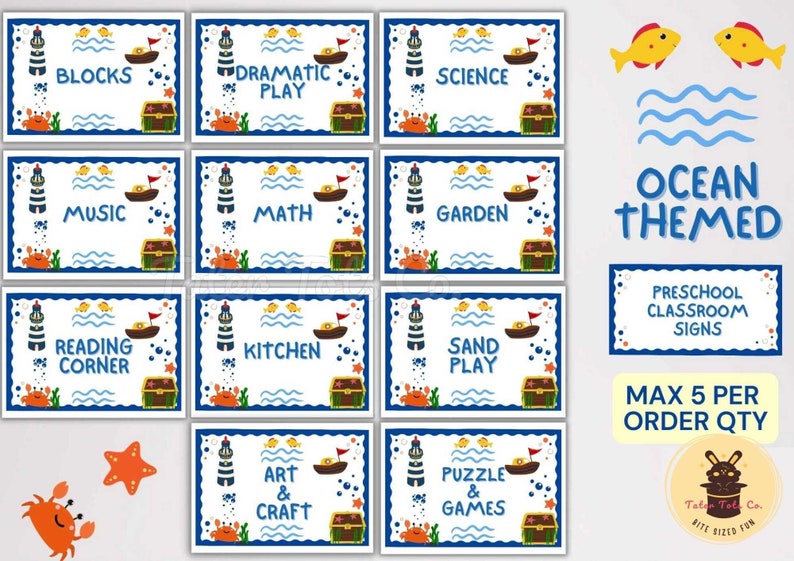

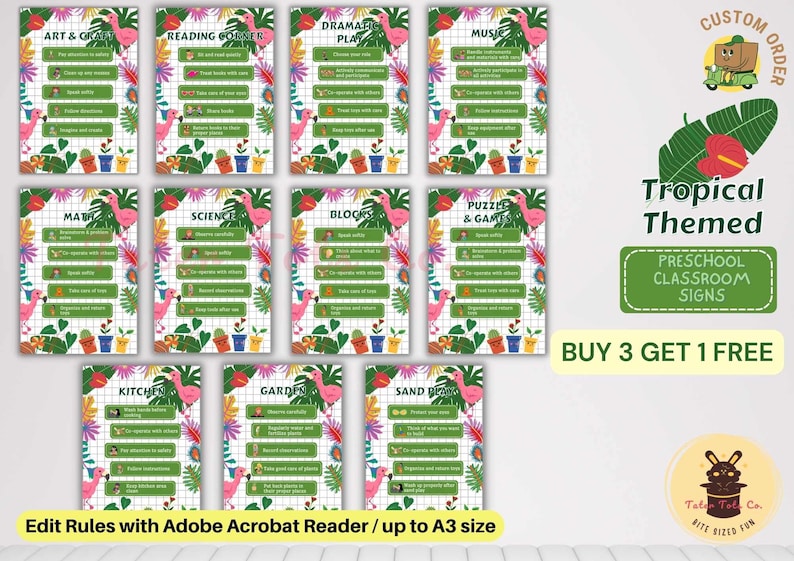
Address Challenging Behaviors Promptly and Proactively
Addressing challenging behaviors promptly and proactively is a crucial aspect of effective classroom management for preschool teachers. It is essential to recognize that young children may exhibit challenging behaviors due to various reasons such as frustration, boredom, or a need for attention. By addressing these behaviors promptly, teachers can create a calm and conducive learning environment for all students.
One proactive approach is to establish clear expectations and rules from the beginning of the school year. By setting consistent boundaries, children understand what is expected of them and what behaviors are acceptable in the classroom. This helps prevent challenging behaviors from arising in the first place.
However, when challenging behaviors do occur, it is important to address them promptly. Ignoring or overlooking such behaviors can lead to a negative impact on the overall classroom atmosphere and disrupt the learning process. Teachers should intervene calmly and assertively, redirecting the child’s behavior toward a more positive alternative.
Additionally, implementing positive reinforcement techniques can be highly effective in addressing challenging behaviors. Praising and rewarding students for displaying appropriate behaviors encourages them to continue making positive choices. This proactive approach not only helps manage challenging behaviors but also promotes the development of self-regulation skills and positive social interactions.
Collaboration with parents is also crucial when addressing challenging behaviors. Regular communication and sharing of observations can provide valuable insights into the child’s behavior patterns and allow for consistent strategies to be implemented both at home and in the classroom.
Self-Care for Preschool Teachers: Taking Care of Yourself to Better Manage Your Classroom
As a preschool teacher, your days are filled with energy, laughter, and endless tasks. It’s easy to get caught up in the chaos of the classroom and forget to take care of yourself. However, practicing self-care is crucial for your overall well-being and can greatly impact your ability to effectively manage your classroom.
First and foremost, make sure to prioritize your physical health. Get enough sleep, eat nutritious meals, and engage in regular exercise. Taking care of your body will not only give you the energy you need to keep up with your little ones but also help you maintain a positive mindset.
In addition to physical health, mental and emotional well-being are equally important. Find activities that help you relax and unwind, such as reading, practicing yoga, or listening to calming music. Taking even just a few minutes each day to focus on yourself can make a world of difference in reducing stress and rejuvenating your mind.
It’s also essential to seek support from others. Connect with fellow teachers who understand the unique challenges of your profession. Share ideas, vent frustrations, and celebrate successes together. Joining professional networks or attending workshops and conferences can provide a valuable source of support and inspiration.
Lastly, don’t be afraid to ask for help when you need it. Reach out to your colleagues, administrators, or even parents for assistance. Delegating tasks and sharing responsibilities can lighten your workload and free up more time for self-care.
Remember, taking care of yourself is not selfish, but rather a necessary step towards becoming the best version of yourself as a teacher. By investing in your well-being, you’ll be better equipped to create a calm and nurturing environment in your classroom, ultimately benefiting both you and your students.
Conclusion
Creating a calm and productive learning environment for preschoolers is crucial for their development and overall educational experience. As a preschool teacher, implementing effective classroom management strategies can make a significant difference in promoting positive behaviors, enhancing learning outcomes, and minimizing disruptions.
We have explored a variety of tips and techniques to help you transform chaos into calm within your preschool classroom. By establishing clear rules and expectations, setting up consistent routines, and utilizing visual aids, you can create a structured and organized environment that fosters a sense of safety and security for your young learners.
We hope you found our article on effective classroom management tips for preschool teachers helpful in transforming your chaotic classroom into a calm and productive learning environment. Managing a classroom full of energetic preschoolers can be challenging, but with the strategies outlined in this article, you’ll be equipped with the tools and techniques to establish routines, set clear expectations, and create a positive atmosphere.
Remember, consistency and patience are key as you implement these tips. Here’s to creating a calm and nurturing space for your little learners to thrive!

Follow us on Facebook/Pinterest for the latest blog updates, freebies, and Ukulele printables.
Warmest Regards,
Access your child's readiness for preschool, know what to prep beforehand, printable templates included.
Here's what's included in the All-in-one preschool preparatory pack,
- Preschool Things to Bring/Pack Checklist
- What I can learn in Preschool checklist
- All About Me toddler activity poster
- Daily activity schedule for parents/child/childminder
- Preschooler daily journal template
- Reward Chart for behavior management
By agreeing to download this printable you will automatically be subscribed to our newsletter to get updates on new content, blog posts, videos, and other freebies straight to your mailbox.
Follow us to receive updates on new content!
